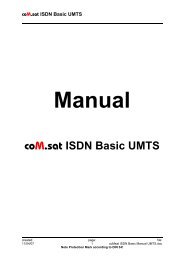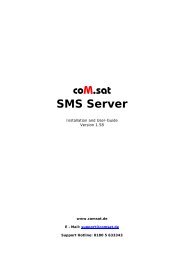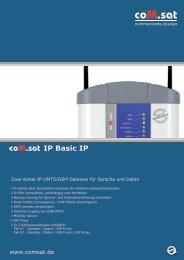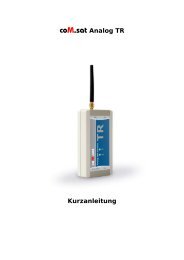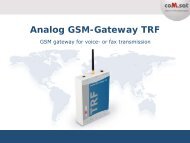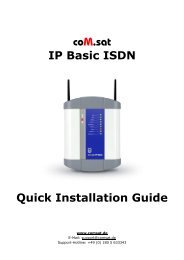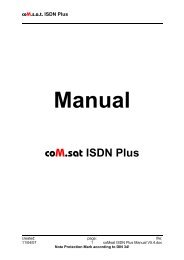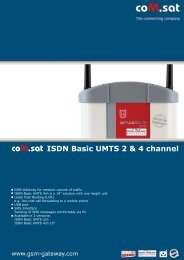coMsat Multichannel PRA
coMsat Multichannel PRA
coMsat Multichannel PRA
You also want an ePaper? Increase the reach of your titles
YUMPU automatically turns print PDFs into web optimized ePapers that Google loves.
<strong>Multichannel</strong> <strong>PRA</strong><br />
6.4.12.1 Configuration<br />
Three codes need to be specified which are used to invoke the call hold ("Hold"), call<br />
retrieve (”Retrieve”) and call transfer service (”Transfer”). All ten digits (0, 1, ...9)<br />
and the * or # signs are allowed. It is possible to configure multiple digits, so that an<br />
erroneous invoking of a virtual PBX function can be avoided. In this case, the desired<br />
function is activated if the configured digits are received in the order specified. The<br />
time between the dialling of the digits does not matter.<br />
Note: Since the # sign is used to terminate overlapped dialling you should be careful<br />
if using it for other functions.<br />
For transferring a call inside the GSM network, an additional setting, the "GSM<br />
transfer sequence", is needed. This is a string containing the digits that would be<br />
dialled manually on a cellular phone, followed by the send key (same as hook off).<br />
Usually these are three digits with ‘*’ in front and ‘#’ behind them, like “*199#“. The<br />
network provider supplies this information.<br />
Note: This feature is not supported in all networks.<br />
If phones connected to the internal ISDN shall be able to call other internal ISDN<br />
phones, it is also necessary to add suitable routing information to the routing table. If<br />
e.g. internal phones have the phone numbers 10-29, an entry is needed that<br />
indicates local routing of numbers starting with “1” or “2” within the internal ISDN<br />
(PBX).<br />
In router mode, a distinction of internal numbers and external numbers that may start<br />
with the same digits is needed. Therefore you should define a special number for<br />
external access or omit the area code (see "Number recognition" parameters).<br />
Figure 45: Virtual PBX parameters<br />
6.4.12.2 Call Hold<br />
During an active call, dialling the configured hold request digit(s) causes the audio<br />
connection to be disconnected. The held user gets the announcement "Call was put<br />
on hold, please wait" (or the march tone if no announcement was assigned) while the<br />
holding user hears the announcement "Call is put on hold, please dial" (or the dial<br />
tone if no announcement was assigned).<br />
The user who has invoked the hold function now is able to dial any other number, i.e.<br />
an internal or external one. This number is dialled using DTMF tones. During<br />
dialling, it is not possible to retrieve the held call, because the retrieve digit(s) would<br />
be evaluated as part of the called party number. Only if the new called number is<br />
date: page: file:<br />
15.02.2008 10:32 54 Manual <strong>coMsat</strong> <strong>Multichannel</strong> <strong>PRA</strong> 3-3 eng.doc<br />
Note Protection Mark according to DIN 34!




